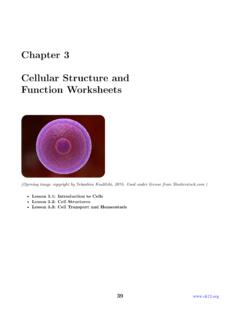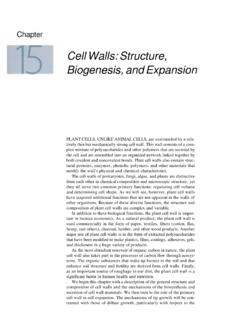Transcription of An Introduction to Biology - Emory University
1 1 An Introduction to Biology 2 Contents chapter 1: Introduction to Biology chapter 2: Theory of Evolution chapter 3: Cell and Genes chapter 4: Growth and Developmental Theory chapter 5: Immune System Tibetan-English Terminology English-Tibetan Terminology 3 chapter 1: Introduction to Biology In its broadest sense, Biology is the study of living things. It can be also called as the science of life from its objective standpoint. All living things or living organisms are studied under this division of science. It pays attention and study on the things related to living organisms such as organization of life, their functions , patterns and order of organisms, growth and development of living organisms and so on.
2 Living things have variety of shapes, forms and functions , and biologists study life in many different ways from the cell at the smallest and ecosystems at large. Due to that, Biology has variety of branches and divisions such as evolutionary Biology , cellular Biology , genetics, growth and developmental Biology and so on. Properties of Life What then do we mean by life? How is the order of living things? Although there is no exact definition of life in general, most of the living things share certain key characteristics. These are, 1. cellular organization. All living organisms consist of one or more cells. The cell is the basic unit of life.
3 Each one of them carries the basic activities of living. Little more explanations shall be seen in chapter 2. 2. Order. All living things are highly ordered. Your body is composed of many different kinds of cells. Each containing may complex molecular structures. 3. Sensitivity. Any organisms are capable of responding to signals and stimuli from its surroundings. Plants grow toward a source of light, and your pupils dilate when you walk into a dark room. 4. Growth, development and reproduction. Any organisms are capable of growing and reproducing, and they all possess genes or hereditary molecules that are passed to their offspring.
4 5. Energy utilization. All organisms take in energy and use it to perform many kinds of work. Every muscle in your body is powered with energy you obtain from the food you eat. 6. Evolutionary adaptation. All organisms interact with other organisms and the environment in ways that influence survival, and as a consequence, organisms evolve adaptations to their environments. 4 7. Homeostasis. All organisms maintain relatively constant internal conditions, different from their environment, a process called homeostasis. These properties are characteristics of all living organisms, and on that basis, we shall have to examine whether things are living or not.
5 More details are given below. Hierarchical Organisation. Is the world of living things in disorder without being organized? As it isn t, any living things do seem to have hierarchical organization. Any living thing falls under a hierarchical level. The representation of level in order to have easier picture of the sense of hierarchy is called hierarchy of life. Hierarchy of life can have variety of level. In general, there is atom at the lowest level to ecology at the highest level, and so, in a nutshell, there are ten levels. If we were to consider in one go from lowest to highest, atom at the lowest, above is the cell, on it is tissue, then organ, then organ system, then organism or person, on it is, population, then community, and ecology at the highest.
6 In fig.(1), the earlier ones are the parts or the composition of later ones and later ones are formed out of the composition of earlier ones. For example, two or more atoms are joined together to form a molecule, and certain molecules are assembled into cell, certain cells are assembled to form tissue and likewise to the later ones. This organization is called hierarchical organization of life. Each level is considered an organization. The cellular Level. At the cellular level, atoms, the fundamental elements of matter, are joined together into clusters called molecules. Complex biological molecules are assembled into tiny structures called organelles, part of cells, which are assembled together to form cells.
7 Nucleus and mitochondria are the basis of organelles. As mentioned above, the cell is the basic unit of life and many organisms are composed of single cells in the world. Bacteria are single cells, for example. All animals and plants, as well as most fungi and algae, are multicellular-composed of more than one cell. More descriptions can be learnt from cell and gene chapter . The Organismal Level. Cells are organized into three levels of organization. The most basic level is that of the tissues, which are groups of similar cells that act as a functional unit such as muscle tissues and blood tissues. Tissues, in turn, are grouped into organs, which are body structures composed of several different tissues grouped together in a structural and functional unit such as heart and brain.
8 Your brain is an important organ composed of zillions of nerve cells and a variety of connective tissues. At the third level of organization, organs are grouped into organ systems. The nervous system, for example, consists of sensory organs, the brain and spinal cord. The Populational Level. Individual organisms are organized into several hierarchical levels within the living world. The most basic of these is the population, which is a group of organisms of the same species living in the same place such as human population and fish population. All the populations of a particular kind of organism together form a 5 species, its members similar in appearance and able to interbreed.
9 At a higher level of biological organization, a biological community consists of all the populations of the different species living together in one place. At the highest tier of biological organization, a biological community and the physical habitat within which it lives together constitute an ecological system, or ecosystem. Emergent Properties Many new properties emerge at the higher level of living hierarchy as we climb up the level from lower to higher level. These are called emergent properties. For example, we can see the properties and energy in a cell that has been formed from the aggregates of so many molecules, which are not present in single molecule.
10 For example, there are properties in molecule such as protein that are not present in atoms that comprised it. That is, if we take a simple example of diamond and coal that are composed of same carbon molecule and even though they are formed differently and yet they have so much difference in terms of their properties and characteristics. We can know from the hierarchy nature of life from the emergent property of life. Note: Hierarchical Organisation and emergent property are the two most important theories in Biology . So, you are asked to heed upon these. 5 Core Themes in all of Biology . Organisation of Life. The Cell Theory As it was stated earlier, all organisms are composed of cells, life s basic units.






